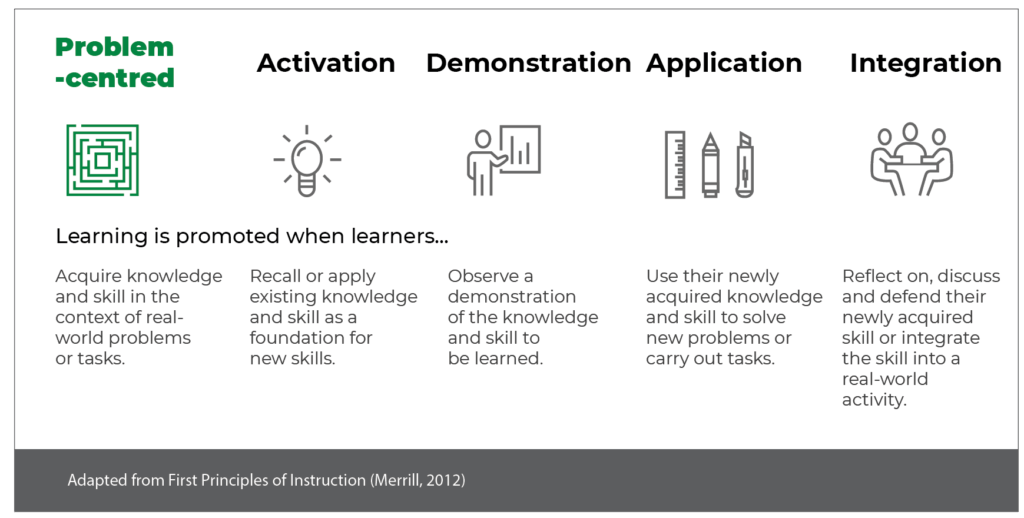Instructional design refers to using methods and techniques to create learning content that is engaging and effective. A skillful use of these principles helps render education material applicable to learning needs and ensures enhanced learning experiences. Value is added to information to not just impart it to the learners but to ensure that it is suitable for the intended target audience. As learning and training moved out of the confines of a classroom, so did instructional design. The coming of the digital age brought with it a dynamic way to learn that was not just limited to gaining information but expanded to hands-on experiences, explorations and active engagement with content and concepts. With the change in learning methodologies, the methods of creating learning content also underwent changes.
Instructional design models
There was a time when emphasis was laid on rote learning and memorizing of content. The 1960s and 1970s saw the rise of concepts like cognitive psychology, and with it emphasis started being laid on problem-solving and critical thinking skills. Instructional design theories saw a shift in this period and strategies that encouraged active learning started becoming more widely accepted. Some of the tools that gained popularity include:
ADDIE Model – Analysis, Design, Development, Implementation, and Evaluation is what ADDIE is all about. It is a linear design model with each step being thoroughly taken care of before moving on to the next. It provides a structured approach to creating learning content.
Gagne’s Nine Events – Robert Gagne, the educational psychologists, was the person who proposed this model. This consists of nine events that are related to the cognitive process of learning. Gain attention, inform about objectives, stimulate recall, provide guidance, elicit performance, provide feedback, assess performance, and enhance retention.
Merrill’s Principles of Instruction – Proposed by M David Merrill, this principle laid emphasis on the idea that engagement with learning content is higher when learners get to solve real-world problems. Merrill’s principle of instruction design focused on task-based learning with the complexity of the task increasing gradually.

While these are not the only principles or models of instructional design, they have been playing a significant role in providing designers with a framework to work with and create effective and engaging learning material.
Impact of technology on instructional design
The need to learn and grow has been consistent across the ages. Trainers have been training and learners have been learning. The shift has taken place in the manner in which learning content is consumed. This has prompted and made it necessary for instructional designers to rethink their principles and adapt them to the changing times. With the coming of online learning, distance learning, virtual reality, and augmented reality training strategies have been updated to adapt to the change.
Transition to digitization of learning content: The transition to learning material from paper to digital has brought in the element of flexibility and variety. Now content can be presented in various ways, allowing designers to offer learners the best possible means of understanding and learning a concept. Images, videos, audio, animations and similar media can be used to explain content. Digitization also allows updates to be incorporated as and when required. As opposed to books, when new editions were expected to carry updated concepts, digital media can make these changes immediately, helping provide updated content to learners.
Immediate feedback: Digital media provides the facility to provide learners with immediate feedback, helping them analyze their own performance instantly and work towards improving upon them. Trainers can also view these performance reports and provide students with the necessary help to rectify mistakes, clarify concepts and enhance outcomes.

Learner-centric designs: Instructional design in the present scenario is focused on creating learning content that is learner-centric. Lessons are designed keeping in mind how the learner will be accessing and absorbing it. The trainer is now a facilitator, and learners are becoming drivers of their own learning journey. The evolution of eLearning, VR, AR, and MR content is giving learners the power to learn and enhance their knowledge, maybe with or without a facilitator.
Micro learning: Evolving education theories are showing that learning material served in small amounts helps understand and retain concepts better. It is not necessary to attend two-hour lectures to understand something. This has given rise to the concept of micro learning, and this has been made possible with digital means of learning, especially the smartphone. Small doses of learning can be taken between breaks or during commutes or when there is just a little time to grab a little small ‘bite’.
Personalized learning: Every learner approaches a course and engages with it in their own manner. Depending upon their unique requirements and learning. Adaptive learning systems make adjustments to content and make it suitable for every level of learner. With personalized learning, learners can better understand in non-judgmental environments and improve upon their understanding and knowledge retention.
Collaborative learning: In the age of the internet, world borders are becoming blurred. Learners can collaborate from any location on the globe. A person sitting in one hemisphere can communicate with another learner in the other hemisphere; they can discuss using online forum like chat rooms, discussion forums, virtual classrooms, collaborative documents etc. This form of learning further helps encourage critical thinking and analytical skills. This requires instructional designers to create content that is not confined to a certain area but can be relevant to any one in any location.
Instructional design in the times of artificial intelligence
The most recent development and a very exciting one has come in the form of artificial intelligence. It is causing ripples in every industry, learning and development has not gone untouched. It is changing the way learning content is created and how learners engage with it. The role of instructional designer is undergoing change. The need is to adapt and understand the role AI can play, employ it as an efficient assistant and use it in the best possible manner to deliver effective learning solutions. Some of the uses of AI include:
Data analysis: By analyzing large amounts of data, AI is helping create content suitable to specific learning objectives and target audiences. While AI does the analysis, instructional designers can focus on the creative part.
Adaptive learning: Integration of AI leads to adaptive learning. The complexity of a course is determined based on the ability and knowledge level of a learner. This ensures that every learner is exposed to challenges appropriate to their level. Complexity increases as their level of understanding develops.
AI tutor: AI also serves as a tutor in many cases. AI-powered virtual characters help learners navigate through a course, identify gaps in learning, provide targeted instructions, and provide feedback. The fact that they are virtual makes it possible for learners to take these courses at their convenience, which would not be possible with a real trainer.
Realistic training: Training scenarios like those offered by AI-Humans provide learners an opportunity to engage in real-world scenarios. Learners get to interact with human-like virtual characters and develop valuable life skills.
Comprehensive feedback: Detailed analysis of user performance done with AI helps provide deep and comprehensive feedback. This minutely points out the pluses and minuses of how a user fared and can provide areas of improvement to help a learner perform better in future.
Technology is changing the way we engage with learning content – the way instructional designers are giving shape to content and how learners absorb and consume learning material. AI is bringing out significant changes in this domain. Ethical questions are also being raised but when used with responsibility, these evolving changes mean this integration of AI in the learning and development field can bring about promising changes. Instructional designers will have to adapt to the changes, get innovative and leverage this piece of technology to create impactful learning experiences.
AI-Humans from ELDC is a SaaS-based platform that enables trainers to develop AI-powered durable skills training solutions within minutes. While all technical aspects of creating these AI-powered scenarios have been taken care of by the team, trainers can devote all their attention towards giving shape to highly effective and relevant training and provide learners with engaging and immersive training opportunities. Practicing durable skills is the best way to learn and this is precisely what AI-Humans is providing.

